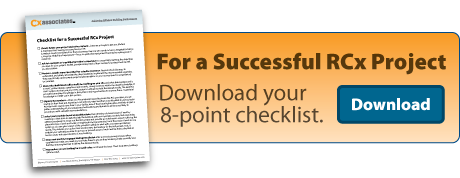The number one barrier to retrocommissioning is the upfront cost of the engineering study. In general, building owners cannot easily determine the potential value of such studies or understand the quality and content that is necessary to support an energy efficiency investment. This makes many customers reluctant to invest $20,000-$70,000 in an engineering study.
The number two barrier to retrocommissioning is the uncertainty and potential lack of persistence of energy savings. A common RCx measure is to develop reset schedules for static pressure or system temperatures. These reset schedules are programmed into the building automation system. And the savings are at risk from the moment they are programmed in – is the program right? Did the operator override the program? Did the controller go down and get reprogrammed with a standard program rather than the correct efficient program?
Addressing these two barriers is essential to developing and delivering a successful retrocommissioning program that will deliver verifiable energy savings for energy efficiency programs by increasing and maintaining the efficacy of building HVAC operations.
A Roadmap Towards Increased Adoption of Retrocommissioning
- Develop standardized tools and requirements
- Build the workforce – RCx providers, controls contractors, and operators need training and capacity development
- Implement a standardized project protocol that includes the following elements:
- Project starts with a walk-through assessment to identify the top priority system and the energy opportunities associated with that system. Includes operator, program administrator (PA) engineer, RCx provider, and controls contractor. RCx provider documents findings in a memo that includes high level estimates of savings, costs, and benefits. (PA funded)
- Project development by the RCx provider including system testing, issues identification, and solutions development. Includes more in depth quantification of savings and benefits.
- Include performance metrics in the project design and incentives
- (PA funded at least partially, but preferably fully funded – risk on PA is priority for addressing the customer barrier.)
- Project design/specification – these types of projects often don’t require significant plans, but rather need specifications and a detailed sequence of operations.
- Project implementation support including external project management, where required, and commissioning – from review of submittals and sequences of operation to functional performance testing
- CxA provides in depth training about the sequences of operation – including ensuring the operators understand the “why” behind each phase of the sequences. Overriding is a topic that must be discussed, but not before the operators understand the logic behind the energy efficient operations.
- CxA provides continuing monitoring (remote DDC) and support to operators.
- Measurement and verification – CxA and PA establish baseline energy use by installing permanent metering on systems before installation to acquire and validate meter data and then continuously monitor system energy performance using performance metrics post installation.
- Incentive design: ideally the energy efficiency programs will cover the full cost of the engineering studies. This has been proven to be cost effective by several existing programs when it is tied to a requirement that owners implement measures up to a cost of $0.25/square foot not to exceed $25,000. Additional incentives can be provided for measures over that cost threshold. This approach overcomes the first cost barrier and, importantly, it gains owner commitment to implement at the outset (like performance contracting) which minimizes the occurrence of subsidized studies that sit on the shelf not saving any energy whatsoever.
There is a clear market demand for retrocommissioning services that provide real results. Implementing retrocommissioning programs that contain these key components will help grow the capacity for identifying and implementing the improvements necessary to improve building operational efficiency and comfort. In addition, it will help build market capacity to undertake the process and better handle the demand from building owners for the services.





